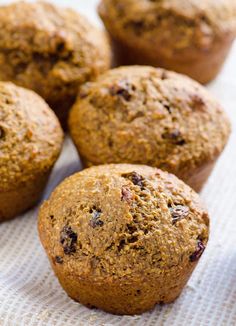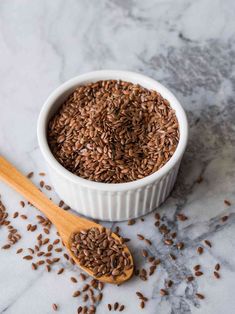Wheat Bran Alternatives

There are several methods for eating properly and staying in shape. Eating healthy and including wheat bran (WB) into your diet is a well-known “secret” to reducing weight.
However, if you find yourself short of wheat bran, we have a solution for you. As you may have surmised, Wheat bran is substituted, but what other comparable goods can be used instead?
Wheat bran replacements include oat bran, flaxseed, wheat germ, rice bran, oatmeal, whole wheat flour, and many others.
Bran is the tough outer coating of the wheat kernel that is removed. It has a sweet taste and a nutty flavor.
It is a rich source of minerals and protein, low in fat and dietary fiber. It aids in the prevention of illnesses and cardiac issues, and it is safe to take, except for individuals who are gluten intolerant.
This is why wheat bran is used in so many recipes - it’s healthful and adds texture and taste to the bread, muffins, and other baked goods.
Wheat Bran Substitutes
1. Oat Bran
Consider the nutrients while deciding whether to consume wheat or oat bran (OB). When it comes to nutrition, wheat bran is the superior choice. WB has more fiber (24.8 grams per cup) than Oat Bran, with just 14.05 grams per cup.
This type of fiber absorbs more water and forms a gel in the digestive tract, which can help protect it. Furthermore, the soluble fiber (known as beta-glucan) accounts for around 17 percent of the oat bran and helps to keep your heart healthy. WB may be more beneficial than OB if you attempt to reduce or keep weight off.
A cup of WB has 125 calories and 2.5 grams of fat. Similarly, a cup of oat bran has 231 calories and 6.5 grams of fat. Thus you should stick to wheat bran. Both include B-complex vitamins, which help your body produce energy. And they both have similar mineral content, meeting nearly all of your daily requirements for magnesium and calcium.
Both contain around 5-6 milligrams of iron and are poor in antioxidant vitamins and phytochemicals with antioxidant effects. To summarise, yes, oat bran may be used as a substitute for wheat bran - both are safe to use and can help you improve your health, but examine what you need to focus on, and remember that variety is beneficial in your diet.
2. Flaxseed

Flaxseeds have been around for generations and can help us enhance our health significantly. Flaxseeds are gluten-free, and it’s no surprise that they’ve been around for so long — a tablespoon of the seeds has 3 grams of fiber, which is 8-12% of the daily requirement.
Because of the fiber composition, it naturally reduces blood sugar. Furthermore, if you are a vegetarian or do not consume fish, flaxseeds can give some of the nourishment you require.
They are high in omega-3 lipids and protein, fatty acids, and other vitamins and minerals. If you want to add variety to your diet, these seeds are the way to go, and many dishes, including flaxseeds.
3. Wheat Germ
If you wish to try Wheat Germ (Link to Amazon) instead of wheat bran, consider that the protein ratio, fiber, and lipids alter. Bran has around 15% protein by weight, over 4% fat, and 42% dietary fiber, whereas germ contains 23% protein, 13% fat, and 12% fiber.
This is primarily due to the larger amount of lipids, and when comparing calories, the germ contains 360 calories per 100 gram while the bran has 216 calories. The vitamin and mineral composition is nearly the same, with slight variations in minerals, zinc, iron, B vitamins, and B-6.
You could be out of bran, but don’t worry since wheat germ and wheat bran can be used interchangeably. Because of their high fiber content, both are utilized in baking. On the other hand, wheat germ is not commonly utilized in recipes.
Stay updated on the expiry date and the temperature in the storage location. Overall, wheat germ is a good substitute for wheat bran.
4. Rice bran
Rice bran is a plant whose outer layer is utilized to produce oil. Rice bran has just 26% fiber, placing it between oat bran and wheat bran. The flavor is lovely, and it goes well with cereal.
It may be difficult to obtain, but it is helpful, and the oil derived from it is quite popular in Japan and India. Rice bran aids in cholesterol reduction. It includes calcium, which aids in the reduction of some types of kidney stones, and is a good WB alternative.
5. Oatmeal
Oatmeal is a popular breakfast option that is also quite healthful. It can reduce your cholesterol and aid in the prevention of heart disease. Oatmeal contains fiber, which is beneficial in various ways, including assisting the body’s insulin synthesis.
It includes B and E vitamins, as well as magnesium. The most crucial aspect is that it is devoid of gluten. As a result, you can include it into your everyday diet and make it a habit.
6. Whole-wheat flour

This flour is created from whole grains but retains many vitamins, minerals, and fiber. This flour is mainly used in baking and to thicken sauces. Look it up on Amazon.
It has an intense flavor due to the high fiber content, and you must use more water while using it, but it is definitely on the list of suitable WB alternatives.
Here are the most often asked questions about wheat bran, so read on to learn more:
Is bran the same as wheat bran?
Wheat kernels are comprised of bran, endosperm, and germ. The outer covering of a wheat kernel is known as the bran. As a byproduct, the bran is extracted and utilized.
What exactly is unprocessed wheat bran?
It’s formed by naturally separating the wheat’s protective outer shell, containing vitamins and minerals. It’s more than simply a fiber supplement; it’s more natural and beneficial to your digestive system.
How much wheat bran should you consume each day?
Typically, up to 20 or 25 grams of WB per day for constipation. 3 to 6 grams per day for high blood pressure. Thirty grams per day for irritable bowel syndrome.











